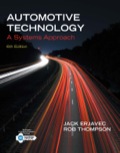
Concept explainers
The CAFÉ standards under which vehicles are tested.
Explanation of Solution
CAFÉ stands for Corporate Average Fuel Economy standards. These were established in 1975 to build more fuel-efficient vehicles to increase the overall fuel efficiency of the vehicles. Under the CAFÉ standards, different models from different manufacturers of vehicles are tested for the number of miles they can be driven on a gallon of gas. Then the fuel efficiencies of these vehicles are averaged together. If the average fuel economy of a manufacturer falls below the usual requirement, then the manufacturer has to cover CAFÉ credits or may have to pay a penalty. For this the car makers have replaced many parts of the engine with new technology and techniques to attain higher fuel efficiency in addition to get increased power output. They replaced many manually operated systems with automatic or electronic system to get more fuel efficient vehicles and also get less emission from burning of fuel.
According to estimation, due to CAFÉ standards, the fuel economy will increase nearly to 54.5 mpg between the years 2017 and 2025.
Want to see more full solutions like this?
Chapter 4 Solutions
EBK AUTOMOTIVE TECHNOLOGY: A SYSTEMS AP
- What is the configuration of the control loop if steam must be shut down in case of a problem? (I found this question on the internet and was wondering what the answer is) A.Valve is fail open, PIC is direct-acting, TIC is reverse acting, and controller algorithm is feed-forwarding.B. Valve is fail open, PIC is reverse-acting, TIC is direct acting, and controller algorithm is cascade.C. Valve is fail closed, PIC is direct-acting, TIC is reverse acting, and controller algorithm is feed-forward.D. Valve is fail closed, PIC is reverse-acting, TIC is reverse acting, and controller algorithm is cascade.arrow_forwardWhat is the procedure to replace the input bellows?(I found this question on the internet and was wondering what the correct answer is out of interest) Remove tubing, old bellows and flapper assembly, install new bellows, connect tubing, install flapper assembly, then calibrate the positioner.Remove tubing, old bellows and cam, install new bellows, connect tubing, install cam, then calibrate the positioner.C. Remove tubing and old bellows, align the quadrant beam, install new bellows and connect tubing, then calibrate the positioner.D. Remove tubing and old bellows, install new bellows and connect tubing, align the quadrant beam, then calibrate the positioner.arrow_forwardGiven the following information: (I found this question on the internet and was wondering what the correct answer is) Firing rate demand = 20% Fuel air ratio = 2:1 Fuel flow = 20% Minimum air flow setting = 5% What is the set point for the air flow controller? 5%B. 10%C. 25%D. 40%arrow_forward
- . Where is a dew point analyzer installed to measure instrument air?(I found this question on the internet and am wondering what the correct answer is) A. AB. BC. CD. Darrow_forwardThe piston at the bottom of the stroke is 0% open. Which adjustment will change the zero setting to 5% open? ( I found this sample question on the internet and was wondering what the correct answer is out of interest) A.Slide component 2 towards the pivotB. Slide component 2 away from the pivot.C. Increase spring tension using adjustment 1.D. Decrease spring tension using adjustment 1.arrow_forward(read image) (Answer: vA = 4.57 ft/sec)arrow_forward
 Automotive Technology: A Systems Approach (MindTa...Mechanical EngineeringISBN:9781133612315Author:Jack Erjavec, Rob ThompsonPublisher:Cengage Learning
Automotive Technology: A Systems Approach (MindTa...Mechanical EngineeringISBN:9781133612315Author:Jack Erjavec, Rob ThompsonPublisher:Cengage Learning Electrical Transformers and Rotating MachinesMechanical EngineeringISBN:9781305494817Author:Stephen L. HermanPublisher:Cengage Learning
Electrical Transformers and Rotating MachinesMechanical EngineeringISBN:9781305494817Author:Stephen L. HermanPublisher:Cengage Learning Refrigeration and Air Conditioning Technology (Mi...Mechanical EngineeringISBN:9781305578296Author:John Tomczyk, Eugene Silberstein, Bill Whitman, Bill JohnsonPublisher:Cengage Learning
Refrigeration and Air Conditioning Technology (Mi...Mechanical EngineeringISBN:9781305578296Author:John Tomczyk, Eugene Silberstein, Bill Whitman, Bill JohnsonPublisher:Cengage Learning


